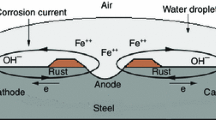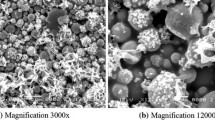Abstract
This paper reviews the literature describing the effects of conducting polymer coatings on the corrosion rate of ferrous alloys (iron, steel and stainless steel). The literature is interpreted in terms of the proposed mechanisms of corrosion protection: barrier, inhibitor, anodic protection and the mediation of oxygen reduction. The most intriguing aspect of the reported literature are the studies demonstrating corrosion protection when deliberate defects were introduced into the coating to expose the bare metal. These studies show that protection afforded by conducting polymer coatings is not due to simple barrier protection or inhibition alone. Many studies illustrate that the polymer/metal interface is modified to produce passivating oxide layers and that charge transfer reactions occur between the metal and polymer. These studies support the proposed anodic protection mechanism, as do the reports of significant ennoblism. On the other hand, there is considerable variation in the reported shift in corrosion potential and these highlight the influence of substrate preparation, coating composition and mode of application and the nature of the electrolyte on the corrosion protection provided by the conducting polymer. For example, the evidence suggests that the emeraldine base form of polyaniline is superior to the emeraldine salt in terms of corrosion protection for steel. However, the number of direct comparisons is small and the reasons for the differences are not well understood. Also not well understood are the role of the counterion release and local pH changes on pinhole protection. It is also argued that the conducting polymer reduces the likelihood of large increases in pH at the polymer/metal interface and so stabilizes the coating against cathodic disbondment. Further work is clearly needed to increase the protection period by further studies on the corrosion protection mechanism so that the polymer composition and processing methods may be optimized.
Similar content being viewed by others
Author information
Authors and Affiliations
Additional information
Electronic Publication
Rights and permissions
About this article
Cite this article
Spinks, G.M., Dominis, A.J., Wallace, G.G. et al. Electroactive conducting polymers for corrosion control. J Solid State Electrochem 6, 85–100 (2002). https://doi.org/10.1007/s100080100211
Received:
Accepted:
Published:
Issue Date:
DOI: https://doi.org/10.1007/s100080100211




